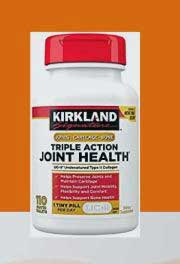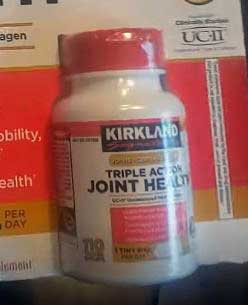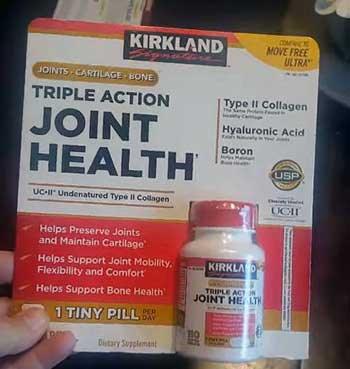
If you’re battling joint pain or simply want to keep your joints in top shape, Kirkland Signature Triple Action Joint Health is a supplement you should consider.
As someone who’s dealt with creaky knees and stiff mornings, I’ve found this product to be a game-changer for mobility and comfort.
With its blend of UC-II collagen, boron, and hyaluronic acid, it targets joint health from multiple angles.
In this article, I’ll share my personal experience, weigh the pros and cons, offer maintenance tips, and compare it to other brands to help you decide if it’s right for you.
My Experience With Kirkland Triple Action Joint Health
A few years ago, I started noticing my knees protesting every time I climbed stairs or went for a long walk. At 45, I wasn’t ready to slow down, but the stiffness and occasional pain were making it tough to stay active. I’d tried other joint supplements before, but they often required multiple pills a day and didn’t deliver noticeable results.
Then, I stumbled across Kirkland Signature Triple Action Joint Health at Costco, and the promise of just one tiny pill a day intrigued me. The price was also hard to beat, so I figured I’d give it a shot.
After about two weeks of taking it daily, I started to feel a difference. My knees didn’t ache as much after my evening walks, and getting out of bed in the morning felt less like a chore. By the one-month mark, I was moving with more ease, and the stiffness that used to linger in my joints had noticeably eased.
I even started hiking again, something I’d scaled back because of discomfort. What stood out was how simple it was to incorporate into my routine—just one small tablet, no fuss, no aftertaste.
I’ve been using it for over a year now, and I’m impressed with how it’s helped me stay active. I’m not saying it’s a miracle cure, but it’s made a real difference in my day-to-day life.
I’ve even recommended it to my parents, who’ve also reported less joint pain. The key, I’ve found, is consistency—taking it every day without fail. It’s not an instant fix, but with time, it’s become a staple in my wellness routine.
Also read: My Thoughts on Seeking Health Vitamins
Pros Of Kirkland Triple Action Joint Health

- Convenient Dosage: You only need one small tablet daily, which is a huge relief compared to other supplements that demand multiple large pills. This makes it easy to stick with, especially if you’re not a fan of swallowing handfuls of capsules.
- Affordable Price Point: Kirkland’s supplement is significantly cheaper than many competitors, offering a 110-day supply for a fraction of the cost of premium brands. This makes it accessible for long-term use without breaking the bank.
- Multi-Action Formula: The combination of UC-II collagen, boron, and hyaluronic acid targets cartilage health, bone support, and joint lubrication. This holistic approach feels like it’s addressing the root causes of joint discomfort, not just masking symptoms.
- Backed By Clinical Studies: The UC-II collagen in this formula is supported by peer-reviewed research showing improved joint comfort and mobility in osteoarthritis patients. Knowing there’s science behind it gives me confidence in its effectiveness.
- No Major Side Effects: For most users, including myself, this supplement is gentle on the stomach with no noticeable adverse reactions. It’s also free from shellfish, gluten, and artificial flavors, making it suitable for a wide range of people.
This supplement’s strengths lie in its simplicity and value. The single-pill regimen fits seamlessly into busy lifestyles, and the cost-effectiveness means you’re not sacrificing quality for affordability. The science behind UC-II collagen is compelling—studies suggest it can reduce pain and improve function in people with joint issues.
I’ve personally felt the benefits, especially during physical activities like hiking or even just daily chores. The absence of side effects is a big plus, as I’ve had issues with other supplements upsetting my stomach. Overall, it’s a practical, research-backed option for joint support.
Cons Of Kirkland Triple Action Joint Health
- Low Hyaluronic Acid Dosage: The 3.3mg dose of hyaluronic acid is far below the 80-630mg used in studies showing joint benefits. This makes me question how much it’s actually contributing to the formula’s effectiveness.
- Limited Efficacy For Severe Cases: If you have advanced arthritis or severe joint damage, this supplement may not provide enough relief. I’ve noticed it works best for mild to moderate discomfort, but it’s not a substitute for medical treatment.
- Boron’s Estrogen Concerns: Boron can increase estrogen levels, which might be a concern for men or women with certain health conditions. I didn’t experience issues, but it’s something to discuss with your doctor if you’re at risk.
- Results Take Time: You need to take it consistently for weeks to notice a difference, which can be frustrating if you’re expecting quick relief. I had to be patient for about a month before feeling significant improvements.
- Not A Complete Solution: While it helps with mobility and comfort, it doesn’t address all aspects of joint health, like inflammation from other causes. I still rely on diet and exercise to complement the supplement’s effects.
The biggest drawback for me is the low hyaluronic acid dose—it feels like a missed opportunity to make the formula even stronger. For those with severe joint issues, this might not cut it, and I can see why some users on platforms like Reddit have called it underwhelming.
The boron issue isn’t a dealbreaker for me, but it’s worth noting if you’re sensitive to hormonal changes. Patience is key, as the slow buildup of benefits can test your commitment. It’s not a cure-all, so you’ll need a broader strategy for optimal joint health.
Maintenance Tips For Kirkland Triple Action Joint Health

- Stay Consistent With Daily Use: Take the tablet at the same time every day to build a habit—I keep mine next to my coffee maker. Consistency is crucial, as the benefits accumulate over weeks of regular use.
- Pair With A Balanced Diet: Eat foods rich in omega-3s, like salmon, and anti-inflammatory ingredients, like turmeric, to boost the supplement’s effects. I’ve found that cutting back on processed foods also helps my joints feel better.
- Incorporate Low-Impact Exercise: Activities like swimming or yoga enhance joint mobility and complement the supplement’s benefits. I started doing yoga twice a week, and it’s made a noticeable difference in my flexibility.
- Stay Hydrated: Hyaluronic acid relies on moisture to support joint lubrication, so drink plenty of water. I aim for at least eight glasses a day to keep my joints feeling smooth and supported.
- Consult Your Doctor Regularly: Check in with your healthcare provider to ensure the supplement aligns with your health needs, especially if you’re on medications. I had my doctor review it to avoid any interactions with my other supplements.
To get the most out of this supplement, you’ve got to treat it as part of a bigger plan. Taking it daily is non-negotiable—missing doses can slow your progress. Pairing it with a nutrient-dense diet and low-impact exercise amplifies its effects; I’ve noticed my joints feel best when I’m eating well and staying active.
Hydration is another simple but effective way to support the hyaluronic acid in the formula. Regular doctor visits keep you safe, especially if you’re juggling multiple supplements or medications. These steps have helped me maximize the benefits and keep my joints in good shape.
Comparison With Other Brands
Move Free Ultra Triple Action
Move Free Ultra is often compared to Kirkland’s supplement because it uses a similar UC-II collagen formula. I’ve tried both, and Move Free feels slightly more potent, possibly due to its higher hyaluronic acid dose. However, it’s pricier and requires two pills daily, which is less convenient than Kirkland’s single tablet. For budget-conscious folks like me, Kirkland offers nearly the same benefits at a lower cost, but Move Free might edge out for those willing to spend more for a slightly stronger formula.
FlexAgain
FlexAgain takes a broader approach, combining glucosamine, chondroitin, MSM, and collagen in higher doses than Kirkland’s. I gave it a try, and while it felt more comprehensive for inflammation, the multiple pills and higher price tag were drawbacks. Kirkland’s simplicity and affordability make it more practical for daily use, but FlexAgain could be better for those with more severe joint issues who need a heavier-hitting supplement.
Osteo Bi-Flex
Osteo Bi-Flex is another popular choice, focusing on glucosamine and chondroitin rather than collagen. I found it less effective for my needs, as it didn’t seem to target cartilage health as directly as Kirkland’s UC-II collagen. It’s also more expensive and requires multiple pills, which can be a hassle. Kirkland’s formula feels more streamlined, but Osteo Bi-Flex might appeal to those who respond better to traditional joint supplement ingredients.
Dr. Joints Advanced
Dr. Joints Advanced blends collagen with anti-inflammatory ingredients like turmeric. I noticed it helped with inflammation more than Kirkland, but the cost is significantly higher, and the pills are larger. For someone like me, who values convenience and price, Kirkland wins out, but Dr. Joints could be a good pick if inflammation is your primary concern and budget isn’t an issue.
Kirkland’s strength lies in its affordability and simplicity, making it a solid choice for most people. However, brands like FlexAgain or Dr. Joints Advanced might suit those with specific needs, like severe inflammation or advanced arthritis, despite their higher cost and less convenient dosing.
Read more: My Thoughts on Dr Talbot’s Mucus and Cold Relief
Frequently Asked Questions (FAQ)
Kirkland Triple Action Joint Health is generally well-tolerated, but some users might experience mild side effects. I haven’t had any issues, but there’s a chance of stomach upset or allergic reactions to collagen, especially if you’re sensitive to chicken-derived ingredients. Boron could potentially increase estrogen levels, which might be a concern for men or women with certain conditions—check with your doctor if this applies to you. Always consult a healthcare provider before starting, especially if you’re on medications or have underlying health issues.
From my experience, yes, it works for mild to moderate joint discomfort. After a month of daily use, I noticed less knee pain and better mobility during activities like walking and hiking. Clinical studies back UC-II collagen’s ability to improve joint function, but results vary. If you have severe arthritis, it might not be enough on its own. Consistency is key—don’t expect overnight miracles. Pair it with a healthy lifestyle for the best outcome.
The benefits include improved joint mobility, reduced stiffness, and better cartilage health, thanks to UC-II collagen. Boron supports bone density, which is great for long-term skeletal health. Hyaluronic acid, though underdosed, may help with joint lubrication. I’ve found it helps me stay active without the nagging pain I used to feel. It’s also affordable and easy to take, making it a practical choice for daily joint support.
Move Free Ultra Triple Action, a close competitor to Kirkland, is designed to support joint health with a similar UC-II collagen-based formula. It’s good for reducing joint pain, improving flexibility, and maintaining cartilage, much like Kirkland’s version. I found it effective, but it’s more expensive and requires two pills daily. It’s a solid option if you’re willing to spend more and don’t mind the extra dose, especially for mild to moderate joint issues.
Conclusion: For Kirkland Triple Action Joint Health
If you’re looking for an affordable, effective way to support your joints, Kirkland Signature Triple Action Joint Health is a smart pick. Its simple one-pill-a-day formula, backed by UC-II collagen research, has helped me stay active and pain-free. While it’s not perfect for everyone, its value and convenience make it a standout. Give it a try, stick with it for a few weeks, and pair it with a healthy lifestyle—you’ll likely see why I’m a fan.
